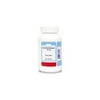
Diphenhydramine is an antihistamine that competitively inhibits histamine binding at the H1 receptors- Antihistamines do not block the release of histamine but compete for uptake at the receptors on sensitive cells in the respiratory tract, intestines, blood vessels and skin- Diphenhydramine is used in companion-animal practice to treat allergies and atopy primarily in dogs- Antihistamines alone can control pruritis in 20-40 of atopic dogs- If antihistamines are unable to control all of the allergic signs, they may be used with corticosteroids, allowing use of a lower dose of the corticosteroids- The sedative effects seen with diphenhydramine use also may help with agitation associated with allergic symptoms- Antihistamines should not be used within a week of skin testing for allergies- Diphenhydramine also may be used as an antiemetic and frequently is used to prevent motion sickness in dogs- H1 histaminergic receptors play a role in the emetic response associated with motion sickness in dogs but not in cats- Diphenhydramine will cause some central nervous system CNS depression and sedation, although the sedative effects may diminish with time- When using oral diphenhydramine for motion sickness, it should be given 30 to 60 minutes before traveling- H1 blockers such as diphenhydramine and H2 blockers such as ranitidine or cimetidine are used in dogs prior to surgical excision of mast cell tumors in order to prevent some of the effects of massive histamine release due to mast cell de-granulation- These drugs generally are continued during the recovery period in order to improve wound healing- Diphenhydramine also is used to treat neurotoxicity or extrapyrimidal effects due to phenothiazines, metoclopramide and tremors due to organophosphate or carbamate poisoning- Chlorpheniramine is the antihistamine-of-choice for pruritis, alopecia and motion sickness in catsPrecautionsIndividuals may react differently to antihistamines- The dose of diphenhydramine should be tailored to the individual animal- Antihistamines should be used with caution in working dogs due to the sedative side-effects- Diphenhydramine should be used with caution in animals with prostatic hypertrophy, bladder-neck obstruction, severe heart-failure, angle-closure glaucoma, pyelo-duodenal obstruction, hyperthyroidism, seizure disorders and hypertension or allergic lung disease COPD- Older humans are more sensitive to side effects from antihistamines- A lower dose of diphenhydramine may be indicated in older animals- High doses of antihistamines can cause birth defects in laboratory animals- Diphenhydramine is excreted in breast milk- It should be used only in pregnant or lactating animals if the benefits outweigh the risks-Drug InteractionsDiphenhydramine may have an additive effect when combined with other CNS depressant drugs, such as barbiturates and tranquilizers or when combined with other anticholinergic agents- Diphenhydramine may enhance the effects of epinephrine- Diphenhydramine may decrease the effects of heparin and warfarin- SKU: PETFLFL11651
| Manufacturer | - |
|---|---|
| Brand | Albolene |
| Item model number | - |
| Color | Multicolor |
| Weight | - |
| Height | - |
| Depth | - |
| Product Id | 270977 |
|---|---|
| User Reviews and Ratings | 3 (1 ratings) 3 out of 5 stars |
| UPC | 306033340329 |
| # | Title | Reviews | User Ratings | Price |
|---|---|---|---|---|
| 1 |
Search on Amazon
Price:
Search
on
|
Search
on
|
||
| 2 |
Mcneil 0012009-50X1000 Diphenhydramine
Price:
$30.09
on
|
$30.09
on
|